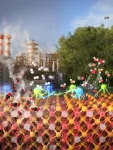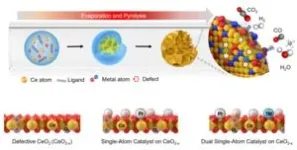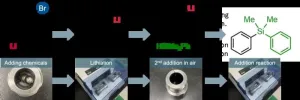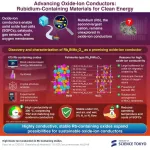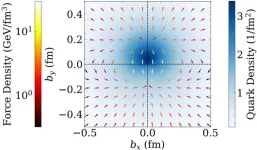(Press-News.org) As the severity of climate change and carbon emissions becomes a global concern, technologies to convert carbon dioxide (CO₂) into resources such as chemical fuels and compounds are urgently needed. Dr. Dahee Park’s research team from the Nano Materials Research Division at the Korea Institute of Materials Science (KIMS), has collaborated with Professor Jeong-Young Park’s team from the Department of Chemistry at KAIST to develop a catalyst technology that significantly enhances the efficiency of carbon dioxide (CO2) conversion.
Conventional carbon dioxide (CO2) conversion technologies have faced challenges in commercialization due to their low efficiency relative to high energy consumption. In particular, single-atom catalysts (SACs) suffer from complex synthesis processes and difficulties in maintaining stable bonding with metal oxide supports, which are crucial for stabilizing catalyst particles and enhancing durability. As a result, the performance of these catalysts has been limited.
To overcome these limitations, the research team developed single- and dual-single-atom catalyst (DSAC) technologies and introduced a simplified process to enhance catalyst efficiency. This achievement utilizes electronic interactions between metals in the dual-single-atom catalysts (DSACs), achieving higher conversion rates and excellent selectivity (the ability of a catalyst to direct the production of desired products) compared to existing technologies.
This technology involves a catalyst design approach that precisely controls oxygen vacancies and defect structures within metal oxide supports, significantly enhancing the efficiency and selectivity of carbon dioxide (CO2) conversion reactions. Oxygen vacancies facilitate the adsorption of CO2 on the catalyst surface, while single and dual-single-atom catalysts assist in the adsorption of hydrogen (H2). The combined action of oxygen vacancies, single atoms, and dual-single atoms enables the effective conversion of CO2 with H2 into desired compounds. Notably, dual-single-atom catalysts (DSACs) utilize electronic interactions between two metal atoms to actively regulate the reaction pathway and maximize efficiency.
The research team applied the aerosol-assisted spray pyrolysis method to synthesize catalysts through a simplified process, also demonstrating its potential for mass production. This process involves transforming liquid materials into aerosols (fine mist-like particles) and introducing them into a heated chamber, where the catalyst is formed without the need for complex intermediate steps. This method enables the uniform dispersion of metal atoms within the metal oxide support and precise control of defect structures. By precisely controlling these defect structures, the team was able to stably form single- and dual-single-atom catalysts (DSACs). Leveraging DSACs, they reduced the use of single-atom catalysts by approximately 50% while achieving over twice the CO2 conversion efficiency compared to conventional methods and an exceptionally high selectivity of over 99%.
This technology can be applied across various fields, including chemical fuel synthesis, hydrogen production, and the clean energy industry. Furthermore, the simplicity and high production efficiency of the catalyst synthesis method (aerosol-assisted spray pyrolysis) make it highly promising for commercialization.
Dr. Dahee Park, the lead researcher, stated, “This technology represents a significant achievement in drastically improving the performance of CO2 conversion catalysts while enabling commercialization through a simplified process. It is expected to serve as a core technology for achieving carbon neutrality.” Professor Jeong-Young Park from KAIST added, “This research provides a relatively simple method for synthesizing a new type of single-atom catalyst that can be used in various chemical reactions. It also offers a crucial foundation for the development of CO2 decomposition and utilization catalysts, which is one of the most urgent research areas for addressing global warming caused by greenhouse gases.”
This research was conducted with support from the Korea Institute of Materials Science's core projects, as well as funding from the Ministry of Science and ICT, the Ministry of Trade, Industry and Energy, and the National Research Council of Science and Technology. The findings were published online in Applied Catalysis B: Environmental and Energy (JCR Top 1%, Impact Factor: 20.3), a prestigious journal in the fields of catalysis and energy.
-----------------------------------------------------------------------
###
About Korea Institute of Materials Science(KIMS)
KIMS is a non-profit government-funded research institute under the Ministry of Science and ICT of the Republic of Korea. As the only institute specializing in comprehensive materials technologies in Korea, KIMS has contributed to Korean industry by carrying out a wide range of activities related to materials science including R&D, inspection, testing&evaluation, and technology support.
END
What if we could revive waste carbon dioxide?
KIMS and KAIST developed catalyst synthesis process and precision control technology to maximize carbon dioxide conversion efficiency
2025-02-21
ELSE PRESS RELEASES FROM THIS DATE:
Mechanochemistry strikes again – A facile means for generating organolithium molecules
2025-02-21
Mechanochemistry using a ball mill demonstrates versatility for generating academically and industrially significant organolithium compounds.
Organolithium compounds, molecules containing a carbon–lithium bond, are excellent precursors for building new carbon–carbon and other carbon–heteroatom bonds. They are widely utilized in both academia and industry for their applications in polymer synthesis, pharmaceuticals, and general organic synthesis. A conventional method for generating organolithiums is done ...
Breakthrough in high-performance oxide-ion conductors using rubidium
2025-02-21
Rubidium could be the next key player in oxide-ion conductors. Researchers at Institute of Science Tokyo have discovered a rare rubidium (Rb)-containing oxide-ion conductor, Rb₅BiMo₄O₁₆, with exceptionally high conductivity. Identified through computational screening and experiments, its superior performance stems from low activation energy and structural features like large free volume and tetrahedral motion. Its stability under various conditions offers a promising direction for solid oxide fuel cells and clean energy technologies.
Oxide-ion ...
Hurricane-proofed downtown skyscrapers unexpectedly vulnerable to ‘bouncing’ winds
2025-02-21
Houston, we have a problem. The ‘Space City’ boasts 50 buildings over 150 meters tall. These were designed to withstand hurricanes, to which Texas is prone. But on May 16th, 2024, a derecho – a wide, long-lived windstorm associated with rapidly moving showers or thunderstorms – managed to cause unexpected damage to many of the tall buildings downtown. The socio-economic impact was significant, due to traffic disruptions, businesses temporarily closing, and the need for repairs.
Why ...
Microcomb chips help pave the way for thousand times more accurate GPS systems
2025-02-21
Optical atomic clocks can increase the precision of time and geographic position a thousandfold in our mobile phones, computers, and GPS systems. However, they are currently too large and complex to be widely used in society. Now, a research team from Purdue University, USA, and Chalmers University of Technology, Sweden, has developed a technology that, with the help of on-chip microcombs, could make ultra-precise optical atomic clock systems significantly smaller and more accessible – with significant benefits for navigation, autonomous vehicles, and geo-data monitoring.
Today, our mobile phones, computers, ...
Illuminating the proton’s inner workings
2025-02-21
Scientists have now mapped the forces acting inside a proton, showing in unprecedented detail how quarks—the tiny particles within—respond when hit by high-energy photons.
The international team includes experts from the University of Adelaide who are exploring the structure of sub-atomic matter to try and provide further insight into the forces that underpin the natural world.
“We have used a powerful computational technique called lattice quantum chromodynamics to map the forces acting inside ...
Genetic therapy gives infants life-changing improvements in sight
2025-02-21
Four young children have gained life-changing improvements in sight following treatment with a pioneering new genetic medicine through UCL Institute of Ophthalmology and Moorfields Eye Hospital, with the support of MeiraGTx.
The children were born with a severe impairment to their sight due to a rare genetic deficiency that affects the AIPL1 gene. The condition, a form of retinal dystrophy, means those affected are born with only sufficient sight to distinguish between light and darkness. The gene defect causes ...
Impacts of workplace bullying on sleep can be “contagious” between partners
2025-02-21
Workplace bullying affects not only the employee’s sleep but their partner’s too, according to new research published today.
Exposure to bullying by superiors and/or colleagues has been linked to a variety of negative health outcomes, such as sleep problems.
Now research by the University of East Anglia (UEA) in the UK, and Complutense University of Madrid and Seville University in Spain, sheds light on the short-term consequences of workplace bullying on various indicators of sleep.
These include waking up too early (sleep severity), interference with daily life (sleep impact) and dissatisfaction with own sleep (sleep satisfaction).
Writing in ...
UK peatland fires are supercharging carbon emissions as climate change causes hotter, drier summers
2025-02-21
A new study led by the University of Cambridge has revealed that as our springs and summers get hotter and drier, the UK wildfire season is being stretched and intensified. More fires, taking hold over more months of the year, are causing more carbon to be released into the atmosphere as carbon dioxide.
Fires on peatlands, which are carbon-rich, can almost double global fire-driven carbon emissions. Researchers found that despite accounting for only a quarter of the total UK land area that burns each year, dwarfed by moor and heathland, peatland fires have caused up to 90% of annual UK fire-driven carbon emissions since 2001 – with emissions ...
Coastal erosion threatens this ancient city — and others much closer to home
2025-02-20
A new USC study reveals a dramatic surge in building collapses in the ancient Egyptian port city of Alexandria, directly linked to rising sea levels and seawater intrusion.
Once a rare occurrence, building collapses in Alexandria — one of the world’s oldest cities, often called the “bride of the Mediterranean” for its beauty — have accelerated from approximately one per year to an alarming 40 per year over the past decade, the researchers found.
“The true cost of this loss extends far beyond bricks and mortar. We are witnessing the gradual disappearance of historic coastal ...
Walgreens supports the American Heart Association to bring CPR to communities nationwide
2025-02-20
DALLAS, Feb. 20, 2025 — The American Heart Association, a global force devoted to changing the future of health for all, and Walgreens, one of the nation's largest community-based pharmacies, are stepping up to support the Association’s Nation of Lifesavers™ movement nationwide. Walgreens will lead efforts in its stores and communities to raise awareness of CPR and drive CPR training and consumer support of the Association’s ...
LAST 30 PRESS RELEASES:
Making lighter work of calculating fluid and heat flow
Normalizing blood sugar can halve heart attack risk
Lowering blood sugar cuts heart attack risk in people with prediabetes
Study links genetic variants to risk of blinding eye disease in premature infants
Non-opioid ‘pain sponge’ therapy halts cartilage degeneration and relieves chronic pain
AI can pick up cultural values by mimicking how kids learn
China’s ecological redlines offer fast track to 30 x 30 global conservation goal
Invisible indoor threats: emerging household contaminants and their growing risks to human health
Adding antibody treatment to chemo boosts outcomes for children with rare cancer
Germline pathogenic variants among women without a history of breast cancer
Tanning beds triple melanoma risk, potentially causing broad DNA damage
Unique bond identified as key to viral infection speed
Indoor tanning makes youthful skin much older on a genetic level
Mouse model sheds new light on the causes and potential solutions to human GI problems linked to muscular dystrophy
The Journal of Nuclear Medicine ahead-of-print tip sheet: December 12, 2025
Smarter tools for peering into the microscopic world
Applications open for funding to conduct research in the Kinsey Institute archives
Global measure underestimates the severity of food insecurity
Child survivors of critical illness are missing out on timely follow up care
Risk-based vs annual breast cancer screening / the WISDOM randomized clinical trial
University of Toronto launches Electric Vehicle Innovation Ontario to accelerate advanced EV technologies and build Canada’s innovation advantage
Early relapse predicts poor outcomes in aggressive blood cancer
American College of Lifestyle Medicine applauds two CMS models aligned with lifestyle medicine practice and reimbursement
Clinical trial finds cannabis use not a barrier to quitting nicotine vaping
Supplemental nutrition assistance program policies and food insecurity
Switching immune cells to “night mode” could limit damage after a heart attack, study suggests
URI-based Global RIghts Project report spotlights continued troubling trends in worldwide inhumane treatment
Neutrophils are less aggressive at night, explaining why nighttime heart attacks cause less damage than daytime events
Menopausal hormone therapy may not pose breast cancer risk for women with BRCA mutations
Mobile health tool may improve quality of life for adolescent and young adult breast cancer survivors
[Press-News.org] What if we could revive waste carbon dioxide?KIMS and KAIST developed catalyst synthesis process and precision control technology to maximize carbon dioxide conversion efficiency
